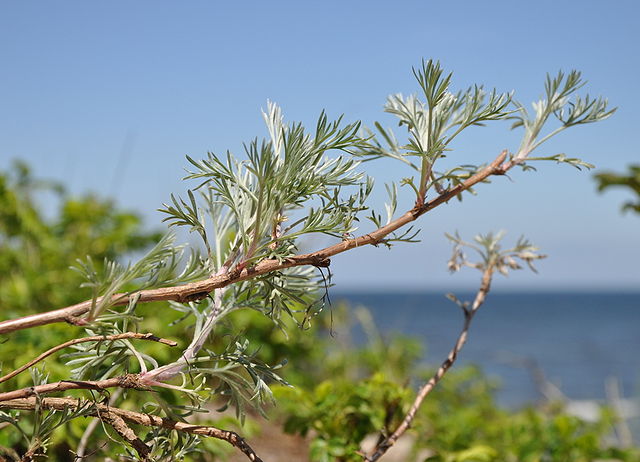 |  |  |   |  |
 |  |  |
Field Wormwood is a perennial plant up to 100 cm tall, but significantly shorter specimens (around 40 cm) are also found. Stem erect or raised, woody at the base, glabrous or slightly velvety hairy. Often the stem has a reddish tone. The leaves are 4-10 cm long, tufted, divided into two or three parts. Young leaves are covered with velvety, silvery hairs, turning dark green as the plant grows. Flowers at the ends of the stem and upper branches, arranged in one-sided dense bunches. Flowers yellow-brown or reddish-brown. After flowering, fruits form - small seed pods.
The rhizome is peg-shaped, woody with many lateral generative shoots.
Blooms from July to October.
In Europe, there are several types (subspecies) of Artemisia campestris, the dominant ones are: subsp. campestris L., subsp. glutinosa (gay ex Besser) Batt., subsp. maritima Arcangeli, subsp. alpina (DC.) Arcangeli, subsp. bottnica AN Lundstrōm ex Kindb and subsp. borealis (Pallas) Hall & Clements.
Field Wormwood is used in complex therapy, as well as for the prevention of various diseases. All plant parts - roots, stems, leaves, flowers and fruits - are used in medicine. Harvesting usually takes place during the flowering of the plant, of course, the roots are dug in the fall and the fruits are harvested when they ripen.
The plant is rich in flavonoids, phenolic acids and terpene compounds. The plant contains flavonoids, chrysin, apigenin, luteolin, 6-hydroxyluteolin, eupathilin, kaempferol, kaempferol rhamnoside, quercetin, rhamnetin, hyperoside, rutin, isorhamnetin, myricetin, pinocembrin, naringenin, sakuratin, hesperidin and eriodictyol, phenolic acids, 4-methoxycinnamic acid, p -coumaric acid, ferulic acid and chlorogenic acid. Esculetin, pectins and terpenoids α-pinene, β-myrcene, β-pinene, 1,8-cineole, limonene, p .-cymene, α-terpinene, γ-terpinene, menthol, α-copene, β-fernesene, cis- nerolidol and caryophyllene oxide.
Field Wormwood essential oil contains spathulenol, alpha cadinol, phytol, caryophyllene oxide, 'salvial-4(14)-en-1-one', alpha-epi-muurolol and vernbenone. In addition, two components that have not yet been identified and named have also been found.
Medicinal significance
According to pharmacological studies, it has been determined that the plant has antioxidant, antibacterial, antifungal, insecticidal, antitumor, hepatoprotective, nephroprotective and antidiabetic effects. Recent studies have shown a positive effect on patients with high arterial blood pressure, by 33-50% in smoking hypertensive patients.
In folk medicine, field Wormwood is used as a remedy for diabetes. It is used to treat digestive, respiratory, metabolic and allergic diseases, and it is also used to treat skin diseases. In ethnomedicine, field Wormwood is also known as an antihypertensive agent, an emmenagogue, and is used to treat kidney and liver disorders.
Laiku vybotne improves the functioning of women's reproductive organs and helps to solve various gynecological problems - to treat illnesses. Reduces the manifestations of gastralgia. Improves lung condition, pulmonary tuberculosis and bronchitis. Helps to improve health in case of diarrhea. Normalizes bladder function in case of cystitis. Helps expel helminths from the body and acts as an antiparasitic agent. Improves the functioning of the digestive tract in case of gastric and duodenal ulcers and gastritis. Relieves toothache and accelerates the healing of oral cavity wounds.
The fresh plant is also used in folk medicine by grinding it and putting it on festering wounds and skin lesions.
Field Wormwood extract acts as an anti-inflammatory, antifungal, antibacterial and antitumor agent. Decoctions are used to treat gynecological problems and diseases of the digestive tract.
Decoctions and infusions are used to treat gastralgia, diarrhea, pulmonary tuberculosis, women's diseases, ostealgia, cystitis and are used as an anthelmintic. The setting is used for rinsing the oral cavity in case of toothache.
The fresh, crushed plant is used to treat festering wounds and as an herbal application.
The plant is used in mixtures with other drugs to treat acute and chronic gastritis, gastric and duodenal ulcers. The setting is also drunk in case of epilepsy.
The extract of field Wormwood suppresses the development of the yeast fungus, the alcohol extract produces activity against tuberculosis. The essential extract of the plant has an antibacterial, antifungal and antitumor effect, the essential oil acts as a bactericide. The extract of the leaves of field Wormwood has anthelmintic and phytoncide properties.
